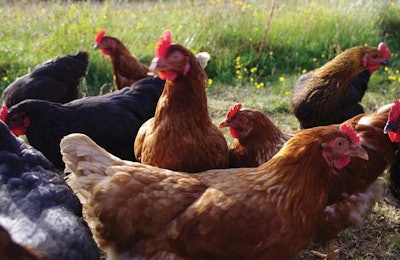
Just like people, chickens need to be challenged a little to perform at their best.
That’s what John Brunnquell, president and founder of Warsaw, Indiana, free-range egg producer Egg Innovations told the Organic Egg Farmers of America Symposium on March 14. The event took place in St. Paul, Minnesota, in conjunction with the Midwest Poultry Federation Convention. Brunnquell is the president of the farming association.

John Brunnquell, president and founder of Egg Innovations, speaks to Organic Egg Farmers of America members and allies on March 14 in St. Paul, Minnesota. | Austin Alonzo
Allostasis
While the growing movement toward producing cage-free, free-range and organic eggs is relatively new, the chicken’s desire to express natural behaviors is not. Hens inherently want to dust bathe, perch, forage, scratch and socialize, and when they get to, good things happen, Brunnquell said. Egg Innovation’s birds have access to pastures year-round and, because of it – along with experienced management – the birds perform better and experience lower mortality than their breed standards.
Brunnquell said the natural behaviors help release the genetic potential of the bird to lay more eggs. It relates to allostasis, or the concept that putting a consistent amount of limited stress on an animal can be beneficial to its health. He compared it to how regular, moderate exercise can benefit people’s overall health.
The birds, he said, need only about two hours a day to lay their eggs, eat, drink and defecate, meaning they have 14 other daylight hours with nothing to do. Chickens are naturally curious and they want to go outside, or at least be engaged inside the house. When they are allowed to express their natural behaviors, negative behaviors like feather pecking and cannibalism can be reduced, he said.
How to engage the birds
All chicken farmers can make simple changes, or get creative with items found on their farm, to engage their animals' natural curiosity.
Brunnquell said the road to good engagement starts in the pullet house. He said as young as four days old, pullets can start learning to interact with engagements in their housing. For instance, Egg Innovations uses rods in its pullet houses to teach pullets how to perch. Perching trains the birds how to jump up and down, and further down the line helps promote evenness of the flock by giving less dominant birds a way to avoid more dominant birds.
Another key engagement is the scratch area which, he said, must be wide enough for the birds to actually use them for scratching. Additionally, litter needs to be present in the area, but it must be shallow enough that the birds do not see it as a nesting area and start dropping floor eggs in the scratch area.
Scratching can help wear down the hens' claws. Similarly, birds can also be given objects to peck at that can blunt their beaks. One Egg Innovations farmer uses a stone wheel with feed placed on top of it so birds can forage for food and shorten their beaks at the same time.
Inside and outside the house, birds should be given curiosity objects that stimulate them and give them something to do. Egg Innovations encourages its farmers to get creative, and they’ve hung old compact disks or swings inside the houses to give the birds something to play with. One even used a soda bottle drilled with holes and filled with oats to get the birds engaged.
Outside, birds want to be engaged in three dimensions. Free-range farmers used to think shade and water were enough, but Egg Innovations learned that curiosity and engagement are valuable outside as well. Birds, of course, want a place to hide if they spot a predator, but they also want things to crawl under, perch on and jump over. Again, it doesn’t need to be complex. Fallen tree limbs or hay bales are sufficient, he said.
Farmers must also remember what looks good to a human farmer – a mowed pasture used to collect farm income – doesn’t look good to a chicken. The birds want dense, deep vegetation. The birds know to come home to the safety of the barn at night.
Farmers and flock managers must also change their own behavior to keep birds engaged and active inside the house. He encouraged farmers to make a little noise while walking the house in order to make birds less afraid of loud noises and disturbances when they are in the pasture. Additionally, farmers should try walking in different directions or wearing different colors at different times of the day. All of these management practices help build up a flock’s stress tolerance. The more their environment changes, the calmer they are.
Comprehensive resource for cage-free eggs available
A new collection of exclusive articles, blogs and infographics on Cage-free Eggs and Consumer Trust in the Poultry Industry, written by trusted WATT Global Media editors and industry experts will equip egg producers and marketers with information to help them make critical business decisions. Purchase your copy.


















